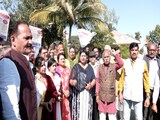Every winter, India's air turns hazy. Between November and January, the mix of smog, fog, and short daylight hours in cities like Delhi, Lucknow, and Chandigarh reduces not just visibility, but also our access to sunlight. This matters because sunlight is our most natural and efficient source of vitamin D, a nutrient vital for bone health, immunity, and even mood regulation. With urban living keeping us indoors most of the week, weekend sunlight rituals like a morning walk in the park, terrace yoga, or cycling outdoors, become crucial.
Yet, the smog season makes stepping outside seem counterintuitive. Can we safely balance the need for sunlight with the need to avoid pollution? And how much exposure is enough to keep our vitamin D levels in check during India's winter months?
In this Sunday Health Reset, we decode the science of sunlight and vitamin D, explain how smog impacts absorption, and explore simple, safe ways to get your weekly sunshine dose, without putting your lungs or skin at risk.
The Science Of Sunlight And Vitamin D
The body synthesises vitamin D3 (cholecalciferol) when UVB rays from sunlight hit the skin. This vitamin then supports calcium absorption, bone health, and immune system regulation. According to the Indian Council of Medical Research (ICMR), around 70-90% of Indians are vitamin D deficient, despite abundant sunlight year-round.
Why the paradox? Urban pollution, darker skin tones, and lifestyle changes mean less direct exposure to sunlight. A 2022 study in the Indian Journal of Endocrinology and Metabolism found that air pollution significantly reduces UVB intensity, directly affecting vitamin D synthesis.
Even in outdoor settings, high levels of PM2.5 particles scatter UVB radiation, making sunlight less effective. This means that even if you're outdoors for 15-20 minutes, your body may produce less vitamin D than it would in cleaner air.
Smog, Skin, And The North Indian Winter
Smog, a mixture of smoke, dust, and fog, peaks in northern India post-Diwali, worsened by stubble burning and temperature inversion. During these months, air quality often falls into the "severe" range, leading to respiratory irritation, inflammation, and decreased oxygen levels.
But there's another hidden cost, namely blocked UVB rays. According to a 2021 study published in Communications Earth & Environment, particulate matter can cut UV radiation by up to 60% in polluted cities.
The impact is double-edged because people stay indoors to protect their lungs, but in doing so, they also reduce their vitamin D exposure. This contributes to the winter fatigue and "seasonal immune dips" many Indians experience.
Photo Credit: Pexels
Weekend Sunlight Rituals That Work
Here's how to safely reclaim the benefits of sunlight even during smog season:
- Catch the early rays (7-9 AM): Morning sunlight offers safer UV exposure and slightly cleaner air before traffic peaks.
- Opt for open, green spaces: Parks or tree-lined areas have better air circulation and lower PM levels than busy roads.
- Terrace routines: Yoga, stretching, or meditation on your terrace can provide both sunlight and mental calm without long exposure to outdoor pollution.
- Go minimalist on sunscreen indoors: If you're in filtered morning sunlight for under 15 minutes, minimal sunscreen on arms and legs can help absorb more UVB (while avoiding burns).
- Eat smart: Complement sunlight with vitamin D-rich foods like fortified milk, eggs, mushrooms, and fish like salmon or mackerel.
- Supplement wisely: If your levels are low (less than 20 ng/mL), doctors often recommend vitamin D3 supplements or fortified foods. Always test before supplementing.
The Mind-Body Connection
Winter sunlight has effects beyond physical health. Exposure to morning light helps regulate the body's circadian rhythm, improving sleep and mood. Studies by the National Institutes of Health (NIH) show that sunlight boosts serotonin levels, which can reduce seasonal affective symptoms or the so-called "winter blues."
Even a short walk in filtered sunlight can trigger a dopamine and endorphin response, improving focus and motivation, especially valuable in the colder, foggier months when lethargy sets in.
Balancing Safety And Exposure During Smog
If AQI levels exceed 300 ("very poor"), limit outdoor exposure to short sessions and use N95 masks to reduce particulate inhalation. Post-smog showers or nasal saline rinses can help clear pollutants from the respiratory tract.
Some UVB lamps and home-based vitamin D devices can also be considered in severe smog zones, but only under medical supervision, as overexposure carries risks of burns or overproduction.
India's winter sun is precious, and paradoxically hidden behind its own haze. While smog season complicates the simple act of "soaking up sunshine," small adjustments can preserve both lung and bone health. Weekend sunlight rituals, like terrace yoga, morning walks, or even reading in the sun, help reset not just vitamin D levels, but also mood and immunity. As we head into colder, foggier months, the message is clear: Seek the sun, but smartly. Stay informed, watch air quality, and make sunlight your ally in surviving the winter health dip.
Disclaimer: This content including advice provides generic information only. It is in no way a substitute for a qualified medical opinion. Always consult a specialist or your doctor for more information. NDTV does not claim responsibility for this information.















